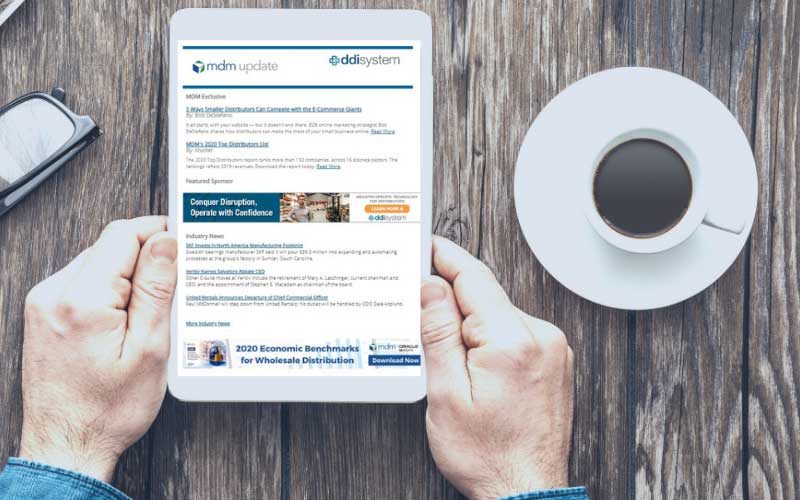Editor’s Note: This is the third article in a three-part Premium series analyzing Ferguson Enterprises and its transformative growth journey in North America. See Part 1 here and Part 2 here. Stay tuned for a comprehensive MDM Case Study report that packages this series with additional insights.
In Part 1 and Part 2 of this series, we explored Ferguson’s diversified growth strategy in the channels the distributor serves, as well as its private label/sourcing strategies. The company’s growth as one of the most successful “channel drifters” has made it a channel leader in the verticals of plumbing, HVAC, residential remodel, waterworks, fire safety, industrial and more.
Here in Part 3, we will dive into how this all comes together in Ferguson’s digital strategy.
Ferguson’s Digital Strategy – Ferguson.com, Build.com, and Ferguson Rewards
It can be difficult to find public data on distributor’s digital initiatives and strategy because of the sensitivity of the effort and the reticence to sharing anything with competitors.
Ferguson is one of the few national distributors that has a second major web domain, www.build.com, in addition to its main domain, www.ferguson.com. There are a handful of other distributors with similar approaches, such as Grainger’s zoro.com, but it is unusual to have multiple major web platforms with different go-to-market approaches.
Ferguson’s build.com mission is to be a best-in-class digital platform combined with brick and mortar to deliver a connected experience.
People have written about omnichannel for years in the industrial supply channel, and Ferguson’s build.com is specifically designed to be an omnichannel solution that is additive to the parent business.

The above graphic outlines the build.com digital “self-service” that is designed to allow end customers (contractors, homeowners, property managers, etc.) the ability to choose the products they may want to install and do that research before they interact with the Ferguson “full-service” team for the order.
The amount of time and resources that Ferguson saves with build.com is difficult to estimate (the company doesn’t share metrics on those savings), but some seem obvious. The build.com customers are doing so much pre-research and product selection that, when they do come in or call to discuss a potential order, that process is already at an advanced stage, helping streamline the buying experience from initial touchpoint to point-of-sale.
I also believe build.com creates customer stickiness when combined with Ferguson’s private label/exclusive brands. Think about how often have use an online tool to design or research a major product purchase from various consumer retailers before eventually going somewhere else to buy your goods or services.
In Ferguson’s case, customers are doing this pre-work often using the Ferguson exclusive brands with exclusive part numbers. So, if they decide to go elsewhere, there is work to do to cross-reference those part numbers and make a purchase (and you may not be able to exactly cross that part number). In theory, this encourages customers to remain within the Ferguson ecosystem.
Build.com is an easy button to do self-service design. I think it’s very likely that the exclusive brands, in tandem with build.com, create a competitive advantage and higher customer conversion rates.
Build.com serves a key function for Ferguson. It gives the customer more of what they want, which is digital self-service for the front-end research. This self-service will likely continue to grow for Ferguson even though what it is selling is a higher dollar purchase amount.
This growth of self-service is happening not just in construction. For comparison, I thought it would be fun to look for some statistics for a big personal purchase that you may often make. A 2022 Cox Automotive Car Buyer Journey survey found that 68% of car shoppers plan to complete most of the car-buying process online. I assume that figure will climb every year.
That is a great example of how end customers desire an ever-growing list of digital self-service solutions even for large purchases.

The second leg of Ferguson’s digital approach is its flagship ferguson.com, which primarily serves its core contractor and commercial customer base with a full eCommerce experience for the distributor’s standard branch-based business. As you can see in the above graphic, Ferguson is adding digital capabilities in three key areas.
- Ordering: An always-evolving solution to create a complete cart-to-ship order. Direct system-to-system ordering (EDI and APIs) from the end customer systems (e.g. Ariba, Coupa, McCormick, etc.) that creates a direct order to the appropriate Ferguson ERP.
- Tracking: Detailed order tracking from the time the pick ticket prints in the warehouse to final delivery with multiple channel notifications (presumably digital, email and text) is an expressed customer need and can be a significant competitive advantage. Many distributor competitors to Ferguson most likely do not have the same level of digital tracking solutions. The other big benefit is how it frees up Ferguson associates perform higher value tasks instead of having to constantly update customers on their order status, since customers can easily see it for themselves.
- Delivery: What Ferguson highlights is less about digital per se. It does fit into its overall self-service strategy with automated lockers and quick pickup services. The overall digital effort improves last-mile delivery.
Ferguson also augments this two-tiered digital approach with a rewards program for customers, with includes a digital component. This long-standing program is kept close to the vest with limited information being shared publicly, but I believe there is enough detail available to draw general thoughts and opinions.
Those in Ferguson’s markets may recall that eight-to-nine years ago the distributor invested significantly in radio and television advertising with football legend Terry Bradshaw as its spokesman for the company’s ProPlus+ rewards program. This was a significant and nationwide launch, using traditional mass marketing media — not common for the channel.

The Ferguson ProPlus+ program was designed with three goals. While details about the program are not publicly shared today, it is likely the greater purpose and goals remain the same as they were when Ferguson refreshed the program in the mid-2010s.
In 2016, Incentive Solutions and Ferguson refreshed Ferguson’s long-term professional trade contractor loyalty program into its current form. According to the 2017 Source Incentive Marketing Awards, the program’s three goals were:
- “Increase long-term trade loyalty program.” Create loyalty with end customer rewards for its loyalty. It’s a simple and effective approach. Buy more = get more.
- “Encourage contractors to purchase online.” Drive online purchases to drive more customer self-service, which is the undeniable trend with Ferguson end customers.
- “Establish better B2B customer relationships.” Create more customer stickiness. When a customer is choosing between two distributors offering competitive pricing and overall value, a reward program can be the tiebreaker over a distributor that only has a smiling face to offer.
Ferguson ProPlus+ is a digital-driven rewards program that undoubtedly achieves those goals. If not, it likely would have been discontinued by now.
The Final Word
So, what can you learn from Ferguson’s digital approach? Are two web platforms feasible to your business? Probably not, based on the average distributors’ size, scale, and capabilities. After all, most of the industry is comprised of small- and mid-sized, independent firms.
If that is the case, what is feasible potentially is the pre-sale research and design that build.com offers; the order confirmation and tracking of ferguson.com; and an understanding that potential programs that drive customer loyalty are worth considering.
Ferguson is investing in all areas to create a foundation for growth. Are you doing the same for your channel business?



